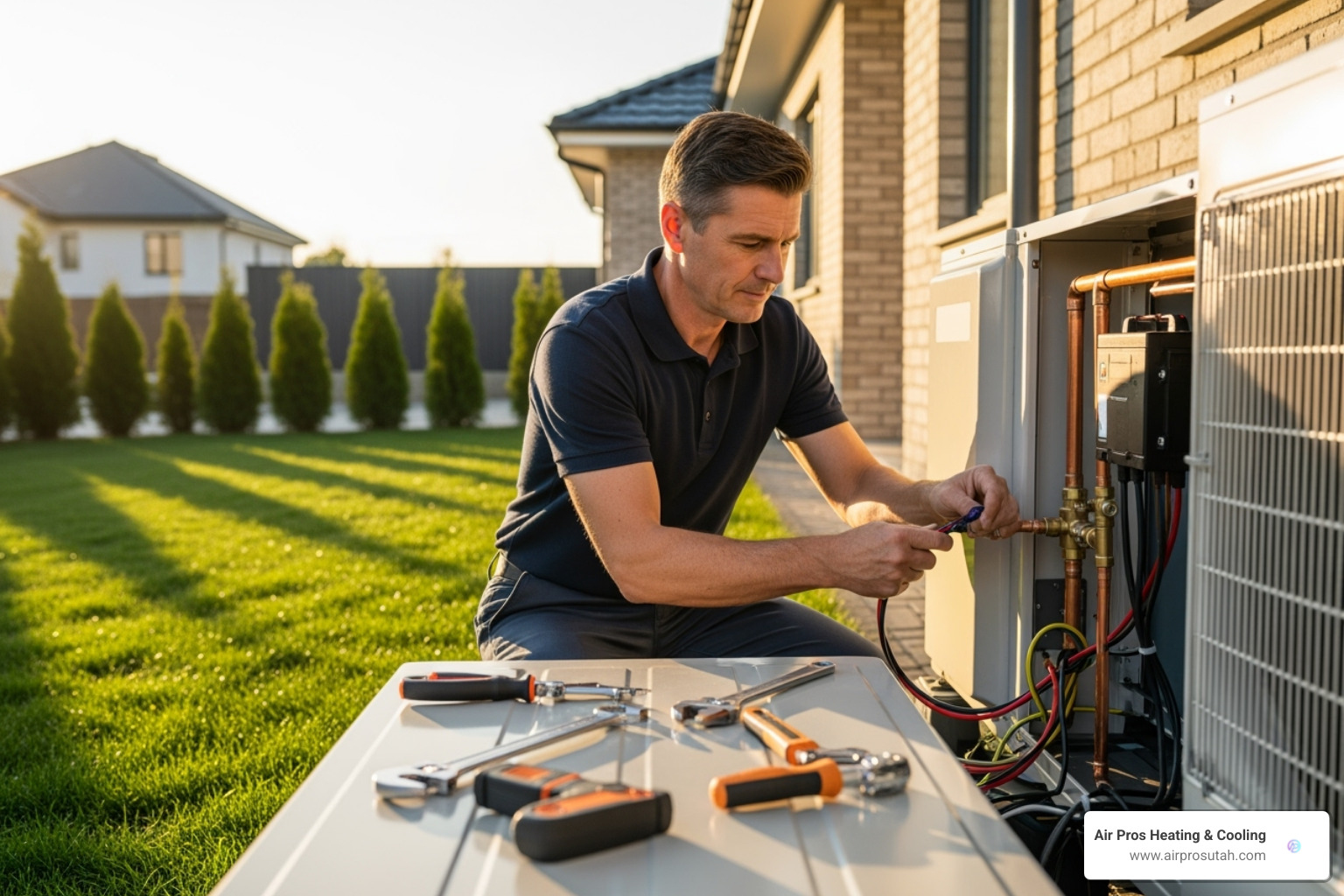
Step-by-Step Guide to Installing a Heat Pump Air Conditioner
Understanding Your Heat Pump Installation Journey
If you're wondering how to install a heat pump air conditioner, you're looking at a smart upgrade for your home. Heat pumps offer incredible benefits. They provide year-round comfort by both heating and cooling your space. They are also super energy-efficient and good for the environment.
The installation process is involved. It takes special skills and tools. Most heat pump installations take a full day, about eight hours. Here’s a quick overview of what the process involves:
- Planning & System Selection: Decide the right heat pump type and size for your home. Look into financial incentives.
- Professional Assessment: A qualified contractor assesses your home and gives you quotes.
- Old System Removal: Safely disconnect and remove your old heating or cooling equipment.
- Unit Placement: Install the outdoor condenser unit and the indoor air handler or evaporator coil.
- System Connections: Run refrigerant lines, electrical wiring, and drainage.
- Testing & Commissioning: The system is powered on, tested thoroughly, and fine-tuned for best performance.
- Ongoing Care: Understand routine maintenance for your new system.
While this guide covers the process, installing a heat pump is complex. It's usually a job for trained professionals. About 90% of HVAC systems are installed incorrectly. This can lead to higher bills and more breakdowns. Plus, a DIY job can void your warranty.
I'm Alex Wiltz, founder of Air Pros Utah. My lifelong passion for HVAC began in high school, and I've built deep expertise in how to install a heat pump air conditioner through years with mechanical and industrial companies.
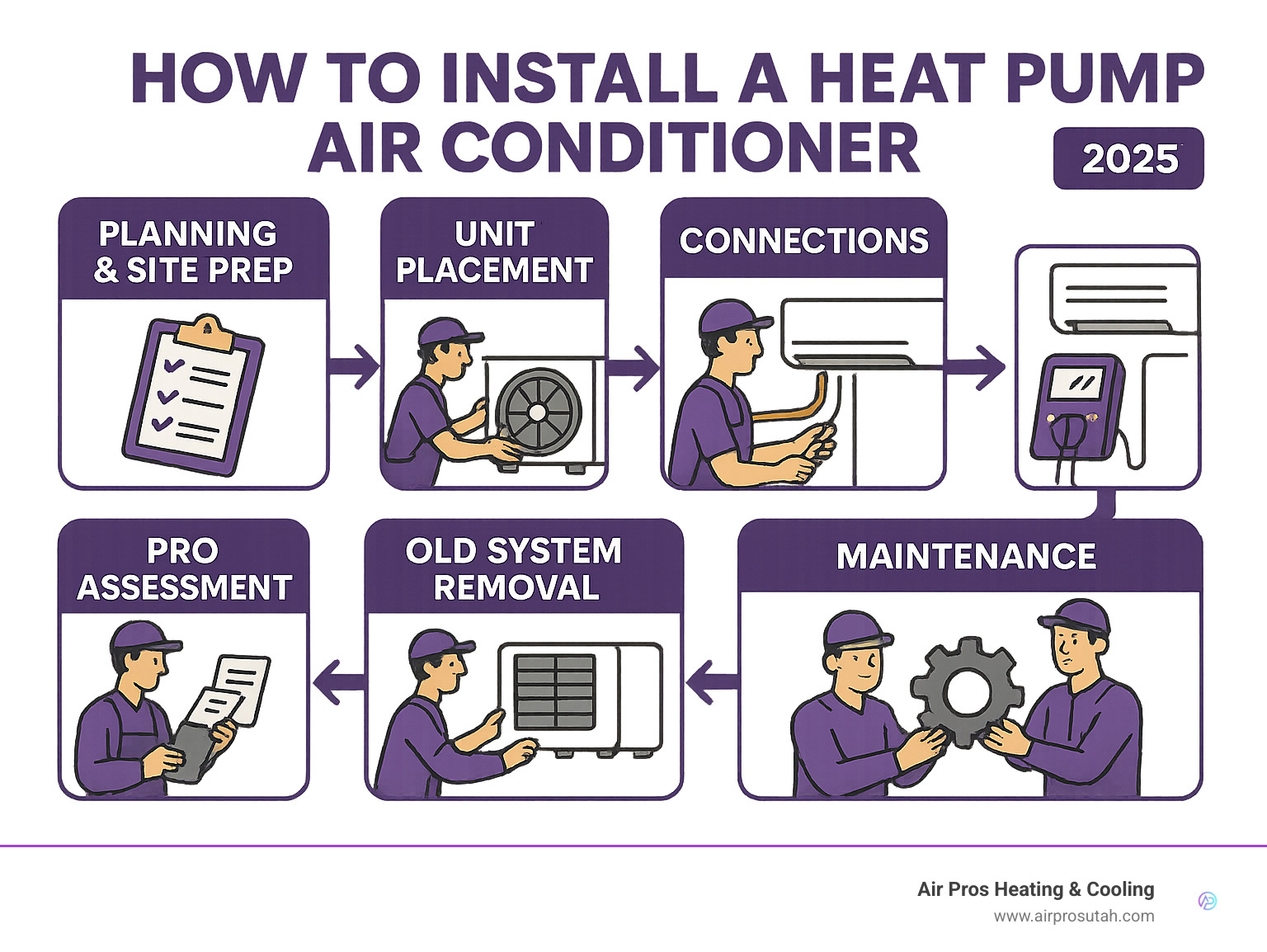
Before You Begin: Planning Your Heat Pump Installation
How to Install a Heat Pump Air Conditioner: A Professional's Step-by-Step Process
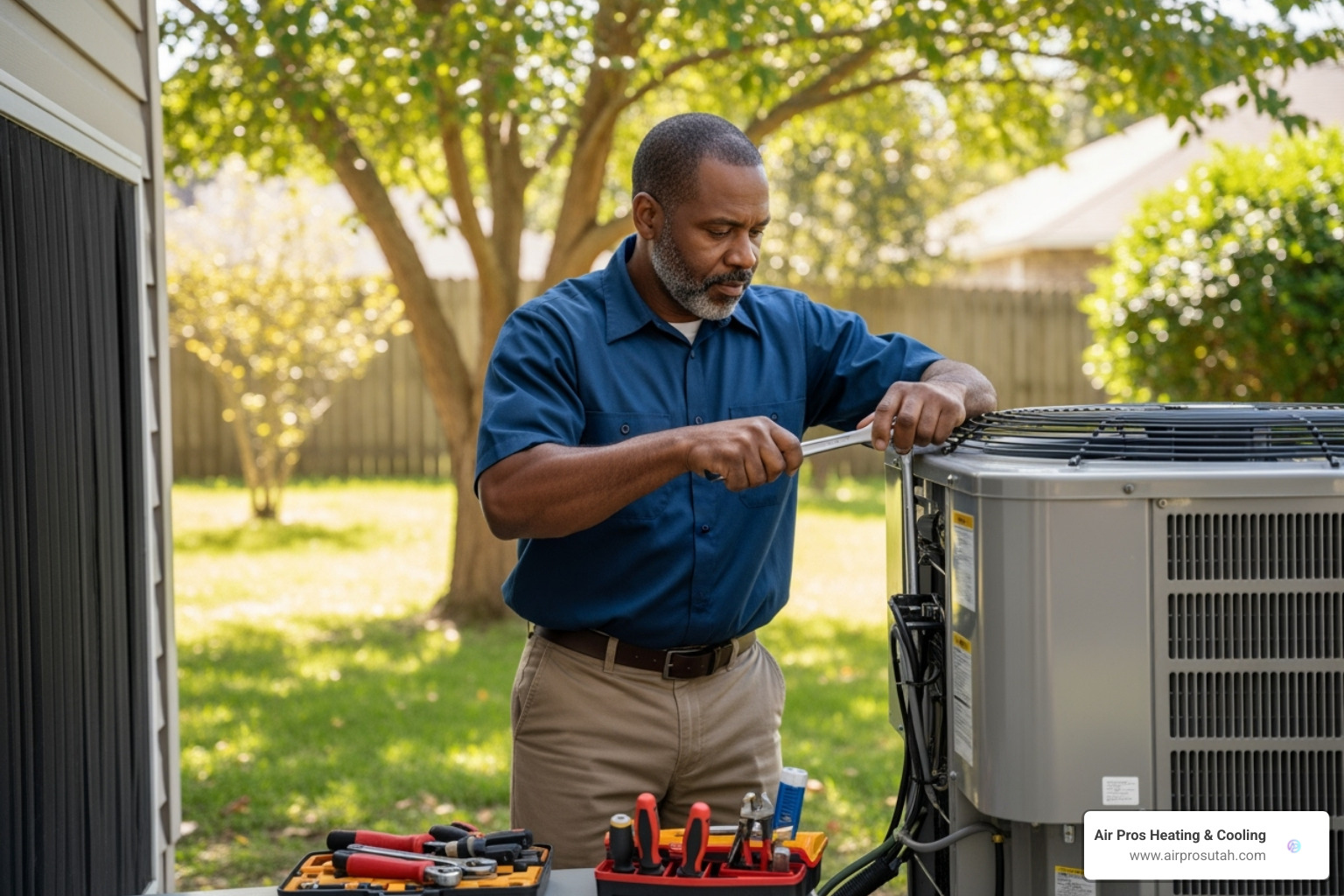
Alright, so you're ready for the main event: the actual installation! While this guide walks you through the journey, it's super important to remember that installing a heat pump is a job best handled by certified pros. Why? Because their expertise means safety, top-notch efficiency, and protection for your system's warranty.
It's a bit unsettling to know that up to 90% of HVAC systems are actually installed incorrectly. This can lead to higher energy bills, annoying breakdowns, and less comfort in your home. Our team at Air Pros Utah takes immense pride in getting it right the very first time. We want your experience to be smooth and your heat pump to run perfectly for years to come.
So, how to install a heat pump air conditioner typically takes about eight hours, often a full day's work. But sometimes, Mother Nature throws a curveball, or we find some unexpected surprises like tricky ductwork, electrical quirks, or the need for extra accessories. These things can stretch the timeline a bit. Don't worry, we'll always keep you in the loop about what to expect on installation day.
Step 1: Site Preparation and Old System Removal
Before we even bring in your shiny new heat pump, we take great care to prepare your home. This means clearing any obstructions around the areas where we'll be working. Think of it as setting the stage for a smooth operation! We'll also lay down tarps and protective coverings to keep your floors and furniture safe and sound. We treat your home just like our own, whether you're in Draper, Sandy, or West Jordan.
Next, it's time to say goodbye to your old heating or cooling system. We safely disconnect and remove your old indoor and outdoor units. This step really highlights why professionals are so crucial: safely handling refrigerant. The EPA has strict rules about venting these substances into the air. Our technicians use special recovery machines to capture and contain them, keeping our environment safe. And let's be honest, an old outdoor unit can weigh up to 300 pounds, so safe removal is key! You can learn more about these guidelines at EPA standards for refrigerant handling.
Step 2: Installing the Outdoor Condenser Unit
The outdoor condenser unit is truly the heart of your new heat pump system. Picking the right spot for it isn't just about looks; it's vital for how well your system performs and how long it lasts. We consider a few key things:
- Airflow Clearance: Your unit needs to breathe! We make sure there's plenty of clear space around it – typically at least 4 inches behind and 20 inches above and in front for mini-splits. We'll steer clear of shrubs or anything that could block that essential airflow.
- Location, Location, Location: We aim to place the unit somewhere that looks good, maybe a little out of sight. We also want it away from windows or busy pathways to keep noise to a minimum and ensure it doesn't get in the way of doors.
- Level Ground: The base for your unit needs to be perfectly level. We often use a gravel base for good drainage, then put a tough composite pad underneath the unit itself.
- Elevating for Snow: This is super important, especially with our snowy Utah winters! (Park City, Alta, or Cottonwood Heights!) We lift the heat pump unit, usually 6-12 inches above the ground. This keeps the coils clear of snow and ice, helping the unit defrost properly.
- Securing the Unit: Once it's perfectly positioned and liftd, we securely mount the unit with the right brackets. This stops it from shifting or vibrating.
Step 3: Installing the Indoor Air Handler / Evaporator Coil
The indoor unit is the other half of the dynamic duo, working with the outdoor unit to bring you comfortable air. How we install it depends on whether you have a central ducted system or a ductless mini-split.
For central systems, we install or replace the indoor evaporator coil. This coil usually lives inside your furnace or air handler and connects directly to your existing ductwork. We generally prefer cased coils because they're easier to install and help prevent any setup issues. Just a heads-up: heat pumps love well-designed ductwork, so sometimes existing ducts might need a little tweaking to match your heat pump's airflow needs.
For ductless mini-split systems, we mount the air handler right onto an interior wall. The best spot for these units is usually high up on a wall, about six feet or higher, ideally a couple of inches below the ceiling. This helps distribute the air evenly throughout the room. We carefully check the room's layout to make sure nothing blocks the unit and that you can easily clean the filters. Once the mounting bracket is secure, we drill a precise 3-inch (or 3.5-inch) hole through the exterior wall. This hole, drilled at a slight downward angle, is where the refrigerant lines, electrical wiring, and condensate drain line will pass through. Want to know more? Check out our insights on Ductless Mini-Split Installation.
Step 4: Connecting the System
This is where all the pieces come together, and your indoor and outdoor units become one unified system.
First, we carefully run the line set – those are the refrigerant lines (suction and liquid lines) that carry the heat-transferring magic between the indoor and outdoor units. For multi-zone mini-splits, indoor units should be mounted no more than 33 feet from the outdoor unit for best performance.
Our skilled technicians use a special process called brazing. This involves using oxygen and acetylene gases with a filler rod to join the copper lines at super high temperatures (over 1200 degrees Fahrenheit!). This creates a super strong, leak-free connection.
Next up is the electrical wiring. Your outdoor heat pump condenser unit needs its own dedicated 120V or 240V electrical circuit. Our qualified electricians handle all the high- and low-voltage wiring, making sure everything is safely and properly connected to your home's electrical panel. We also install a new disconnect box near the outdoor unit – it's a handy safety feature for maintenance.
Then there's the condensate drain line. When your indoor unit cools and dehumidifies, it produces water. This drain line carries that water away, making sure it exits neatly underneath the line set and drains properly.
Once all the lines are through the wall, we carefully seal the wall penetration using caulk, neoprene, and low-pressure foaming sealant. All holes are properly spray-foamed for weatherproofing and hidden from view, keeping your home cozy and looking great.
Finally, we install your new thermostat, often a smart one! This lets you precisely control your brand-new heating and cooling system with ease.
Step 5: Commissioning and Testing
The installation isn't truly complete until we've thoroughly commissioned and tested your new heat pump. This final phase is super important for making sure your system runs at its best, is energy-efficient, and meets all warranty requirements.
Before we even turn on the power, we do a series of final checks. We make sure all connections are secure, lines are properly insulated, and everything is ready to go.
Once powered on, your heat pump goes through a commissioning process. This usually takes about 45 minutes to 2 hours or even more – it's a bit longer than a standard AC unit because we need to test both heating and cooling functions. During this time, the refrigerant settles, and the system calibrates itself.
Then comes the comprehensive testing. We put your heat pump through its paces, rigorously checking all operating modes: heating, cooling, the defrost cycle, and emergency heat. We verify proper airflow, check for any refrigerant leaks using special tools (and a simple soapy water test!), and ensure your new thermostat is talking nicely with the system. We perform both a pressure test and a vacuum decay test with digital gauges to make sure the lines are clean and all connections are tight.
Finally, before we pack up, our lead installer will do a final walkthrough with you. We'll explain your new heat pump system, show you how to operate the thermostat, go over safety features, discuss maintenance needs, and answer any questions you might have. We'll also make sure all material and old equipment are loaded up and taken away, leaving your home swept clean. Our goal is to make sure you feel confident and comfortable using your new system from day one.
DIY vs. Professional Installation: The Critical Difference
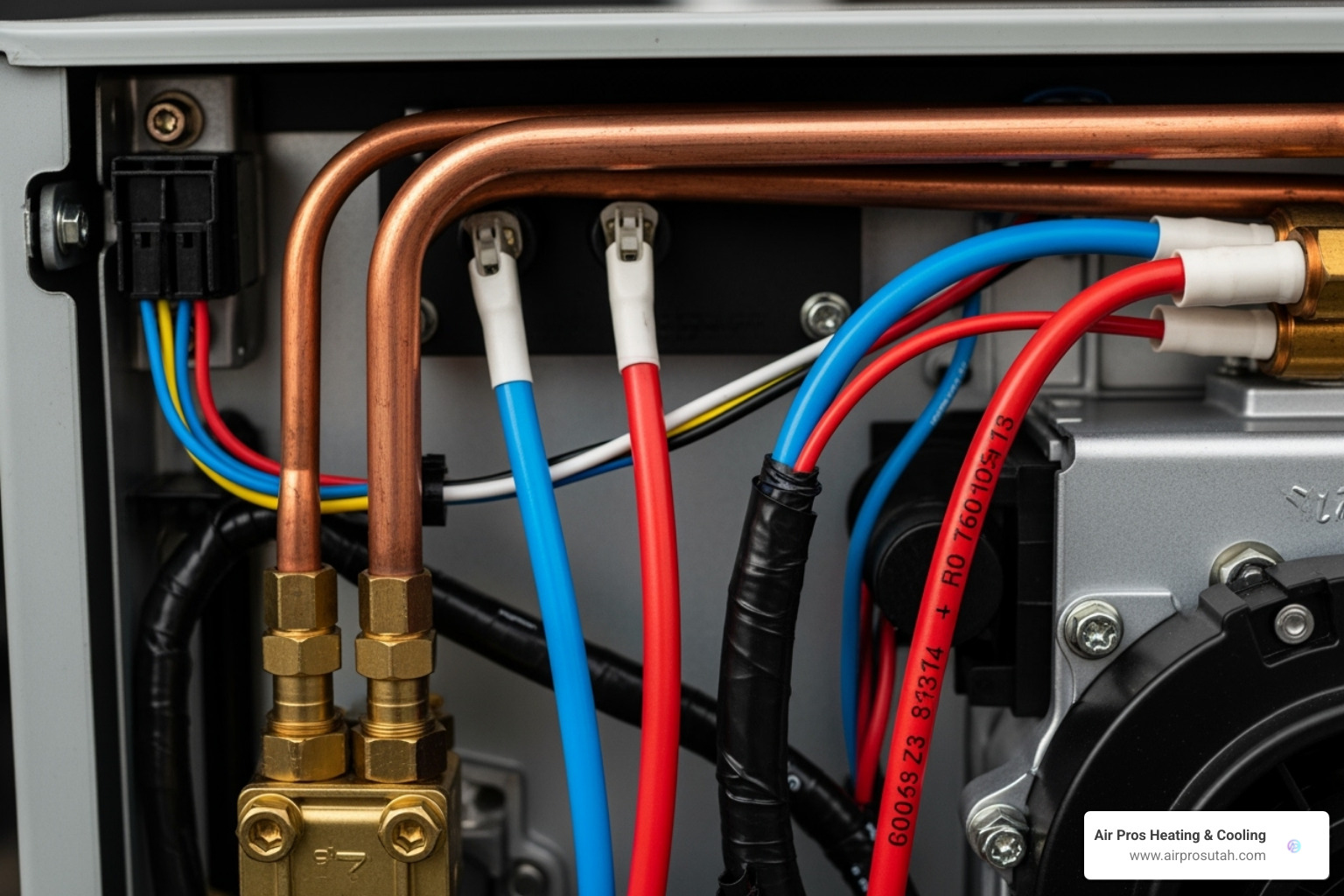
You might be looking at all the steps we've covered and thinking, "This sounds like a lot! Can I really learn how to install a heat pump air conditioner myself?" It's a natural thought. The idea of tackling a DIY project can be very appealing, especially if you're hoping to save a bit on costs.
However, heat pump installation is incredibly complex. It's not just about connecting a few pipes; it involves precise calculations, handling specialized refrigerants, and navigating high-voltage electrical work. In fact, studies show that a staggering 90% of all HVAC systems are installed incorrectly. You can read more about why this happens here: Why most HVAC systems are installed incorrectly.
An improperly installed system won't just run poorly; it can lead to higher energy bills, frequent breakdowns, and a shorter lifespan for your expensive new unit. Beyond performance issues, there are serious safety hazards. You're dealing with live electricity and specialized refrigerants that require careful handling and disposal according to EPA standards. Trying to install a heat pump without the right training and tools can lead to electric shock, dangerous refrigerant leaks, or even explosions. It’s also illegal to vent refrigerants into the atmosphere.
Think about your warranty, too. Most heat pump manufacturers require professional installation by a certified technician to keep your warranty valid. A DIY or unlicensed job could void it, leaving you responsible for costly repairs down the line. And don't forget building permits! Most areas, including those in the SLC Valley, require permits for HVAC installations to ensure they meet local safety and building codes. Without them, you could face fines, issues selling your home, or problems with your home insurance.
Why You Should Hire a Qualified Heat Pump Installer
Hiring a qualified heat pump installer, like our team at Air Pros Utah, gives you real peace of mind and ensures your investment truly pays off. We're committed to making sure your system works perfectly from day one.
Our team consists of licensed and insured technicians who are trained specifically in heat pump technology. This protects you from any liability and guarantees the work meets the highest standards. We come equipped with the proper tools and training for every step of the process. This includes performing a detailed Manual J Load Calculation to ensure your system is perfectly sized for your home. We also make sure every installation adheres to local codes across Utah cities like West Valley City, South Jordan, and Tooele, ensuring your system is both safe and compliant.
When you choose us, you're not just getting an installation; you're getting a guarantee. Our professional work ensures your manufacturer warranty remains valid, protecting you from unexpected repair costs. Most importantly, we ensure your heat pump operates at its peak efficiency, providing optimal comfort and the energy savings you expect.
When you're looking for an installer, always get multiple quotes (we recommend at least three!). Check their certifications, like NATE or ACCA, ask for references, and read customer reviews. Don't hesitate to ask detailed questions about their specific experience with heat pumps. We invite you to learn more about our services and see how we can help: Explore Heat Pump Services.
A Note on DIY Mini-Splits: Can I learn how to install a heat pump air conditioner myself?
You might have come across DIY-marketed mini-split kits that claim to be "easy to install" for homeowners. Some of these units, like the MRCOOL DIY, even come with pre-charged lines. This means you don't need specialized HVAC tools, like a vacuum pump, to "flush" the lines, which simplifies one of the trickiest parts of the installation process.
However, even with these seemingly simpler kits, there are still important complexities to consider:
- Electrical Circuit Installation: While the unit itself might be marketed for DIY, you'll almost certainly need a licensed electrician to run a new, dedicated 120V or 240V electrical circuit to the outdoor condenser unit. This is not a task for the inexperienced.
- Proper Mounting and Sealing: Mounting the indoor unit securely and ensuring the hole through your wall is perfectly sealed (with a slight downward angle for drainage) is crucial. If not done right, you could end up with leaks, drafts, or poor performance.
- Potential for Leaks: Even pre-charged lines can develop leaks if they're not connected perfectly. Checking for leaks with specialized tools, or even a simple soapy water test, is a must.
- Sizing and Placement: Choosing the right size unit for your space and finding the optimal placement for both indoor and outdoor units for maximum efficiency and comfort still benefits greatly from professional insight.
While a DIY mini-split can seem significantly cheaper upfront, the potential for performance issues, voided warranties, or even safety hazards if the job isn't done perfectly still exists. For true peace of mind and guaranteed performance, we always recommend professional oversight, even for these simplified units. If you're curious about how easy these systems can be to install, check out our insights on Are Ductless Mini-Splits Easy to Install?.
After the Installation: Maintenance and Care
Congratulations! Your new heat pump is now installed and ready to provide your home with perfect, year-round comfort. But the journey doesn't end there! Just like any valuable investment, your heat pump will thrive with a little ongoing love and attention. Think of it this way: a well-cared-for system runs smoothly, saves you money on energy bills, and will stick around to keep you comfortable for many years to come.
So, what does this "love and attention" look like?
First and foremost, we highly recommend scheduling annual professional servicing for your heat pump. You wouldn't skip an oil change for your car, right? Your heat pump is just as important! During these yearly check-ups, our skilled technicians will go under the hood, so to speak. They'll carefully check refrigerant levels, give the coils a thorough cleaning, inspect all electrical components, and make sure everything is running exactly as it should. This proactive approach is like having a superhero for your system – it catches small issues before they can turn into big, expensive problems.
Next up is something you can easily take care of yourself: changing your air filters. This simple task makes a huge difference! We suggest cleaning or replacing your filters every 1 to 3 months. If you have furry friends running around or suffer from allergies, you might even want to do it a bit more often. A clogged filter is like trying to breathe through a stuffy nose – it makes your heat pump work much harder, gobbling up more energy and driving up your bills. Keep those filters clean for smooth, efficient airflow!
Don't forget the outdoor hero of your system! It’s important to keep your outdoor unit clear of anything that might block its airflow. This means regularly clearing away leaves, dirt, grass clippings, and especially snow and ice. Living in snowy areas like Heber City or Park City, we know how quickly snow can pile up. Make sure it doesn't build up around or on your outdoor unit. A clear path for air helps your heat pump breathe easily and perform its best.
By following these simple maintenance steps, you're not just ensuring efficiency; you're also maximizing your heat pump's lifespan. A well-maintained heat pump typically lasts 10 to 15 years, sometimes even longer! That's a fantastic return on your investment, protecting your home's comfort and your wallet for years to come.
For comprehensive care and to keep your system performing beautifully, explore our Heat Pump Maintenance services. And because comfort isn't just about temperature, we also offer Indoor Air Quality Services to ensure the air you breathe is as clean and fresh as it is comfortable.
Frequently Asked Questions about Heat Pump Installation
Got questions about your new heat pump? That's perfectly normal! We understand you want to know all the ins and outs of your home comfort investment. Here are some of the most common questions we hear, answered with clarity and warmth.
How long does it take to install a heat pump?
You're probably wondering how long you'll be without your current system. Typically, installing a heat pump is a one-day affair! We usually complete the entire process in about eight hours, aiming to have your new system up and running before the day is out. This includes everything from gently removing your old equipment to installing the new indoor and outdoor units, running all the necessary lines, making electrical connections, and thoroughly testing every function.
However, sometimes a home might have unique needs. If we need to make significant changes to your ductwork, upgrade your electrical panel, or if the units are in a tricky spot, the installation might stretch into a second day. We'll always give you a clear estimate of the timeline during your initial consultation so you know exactly what to expect. We want to make sure the job is done right, not just quickly!
What is the average cost to install a heat pump?
Let's talk about the investment. For a standard, ducted heat pump system that warms and cools your entire home, the average cost for purchase and installation typically hovers around $6,000. If you're considering the fantastic flexibility of ductless mini-split heat pump systems, you're usually looking at about $3,000 per zone.
Now, these are averages, and the total cost can vary quite a bit. We've seen prices range anywhere from $3,200 to $36,000 for ducted systems, and $600 to $14,500 for mini-splits. Why such a big range? Well, it depends on a few key things: the size and power of the system your home needs, its efficiency rating (like SEER/HSPF), the brand you choose, and how complex the installation is. For example, if your home needs brand-new ductwork or an electrical panel upgrade, that will add to the overall cost. Don't forget, there are often great rebates and tax credits available that can help bring that price down significantly!
What maintenance does a new heat pump require?
Think of your heat pump like a trusty car – it needs a little regular care to keep purring along happily! Just like a traditional furnace or air conditioner, your heat pump thrives on consistent maintenance. This ensures it runs efficiently, lasts longer, and keeps your energy bills in check.
Here's what you can easily do yourself:
- Change your air filters: This is a big one! We recommend cleaning or replacing your air filters every 1-3 months. If you have furry friends or a particularly dusty environment, you might need to do it even more often. A clean filter helps your heat pump breathe easily.
- Keep the outdoor unit clear: Make sure the outdoor unit is free from leaves, dirt, grass clippings, and especially snow and ice. Good airflow around the unit is key to its performance.
Beyond those simple DIY tasks, we highly recommend having a professional HVAC technician perform an annual tune-up. During this yearly check-up, we'll go through everything with a fine-tooth comb: checking refrigerant levels, cleaning coils, inspecting all the electrical components, and making sure every part is working perfectly. This routine professional maintenance isn't just about preventing breakdowns; it helps maintain your heat pump's top efficiency and truly extends its lifespan. It’s a small investment that pays off big in comfort and savings!
Get Your Heat Pump Installed by the Experts
So, you've learned a lot about how to install a heat pump air conditioner – from the initial planning to the detailed steps a professional takes. It's clear that while the idea of a heat pump is exciting for your home's comfort and energy savings, the installation itself is a complex journey best steerd by experts.
Choosing a professional installation isn't just about getting the job done; it's about making a smart, long-term investment. It means ensuring your heat pump operates at peak efficiency, provides reliable heating and cooling for years, and avoids costly headaches down the road. A perfectly sized and installed system means lower energy bills and consistent comfort, avoiding the pitfalls of DIY or inexperienced work.
At Air Pros Utah, we're passionate about delivering exactly that. Our team specializes in providing custom solutions, carefully ensuring your new heat pump system is perfectly suited to your home's unique needs. We pride ourselves on not just installing equipment, but on delivering year-round comfort with clear communication, fair pricing, and building lasting relationships with our customers.
Ready to experience the difference a professionally installed heat pump can make? For expert advice and a truly seamless installation experience, whether you're in Salt Lake City, Riverton, or any of our service areas across the SLC Valley, we're here to help. Contact us today to schedule your consultation and let's get your home comfortable the right way.

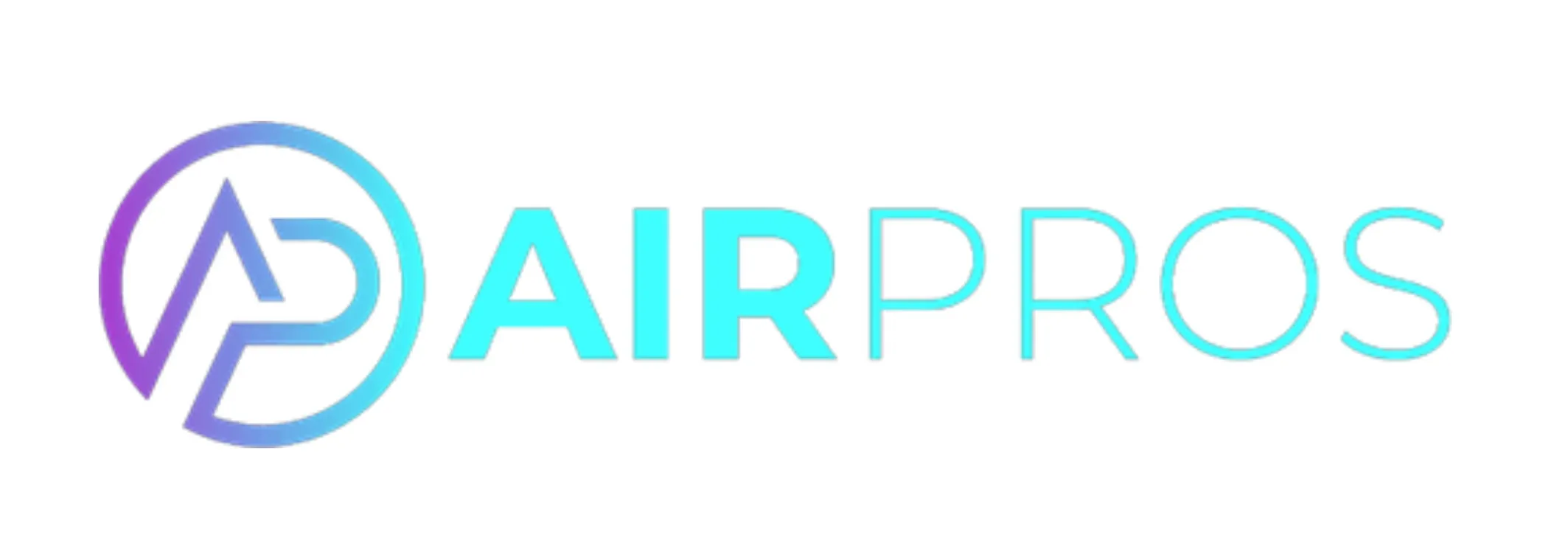
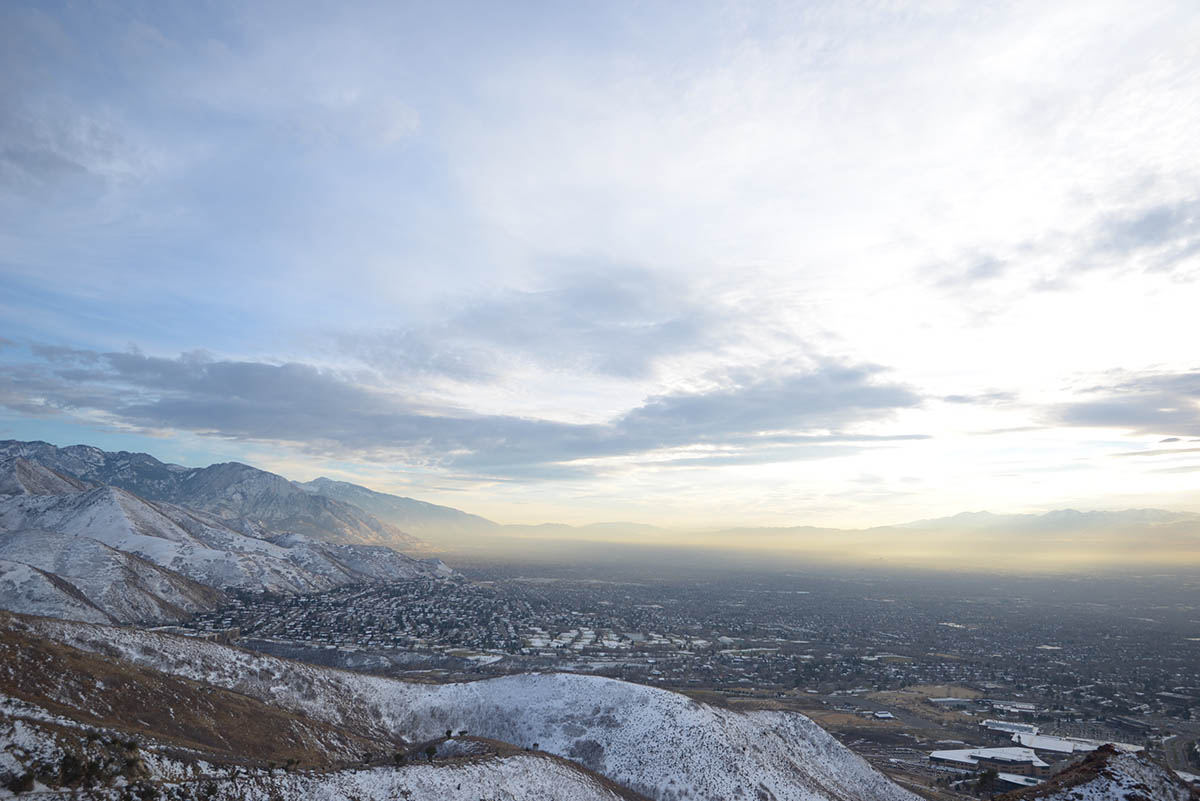
.jpg)